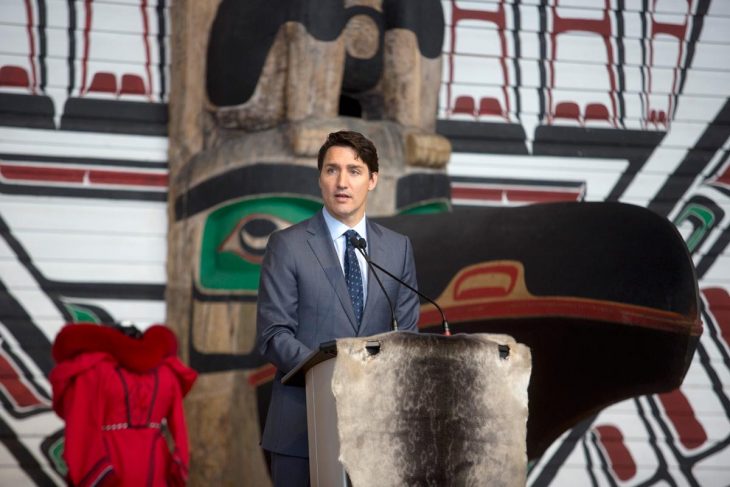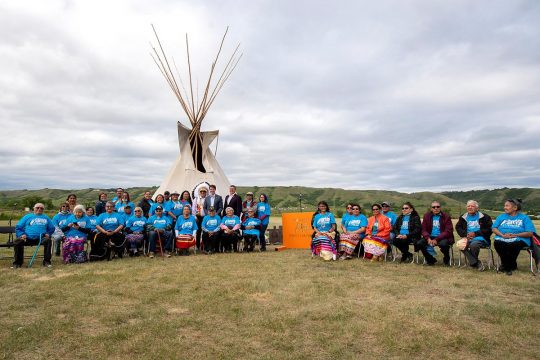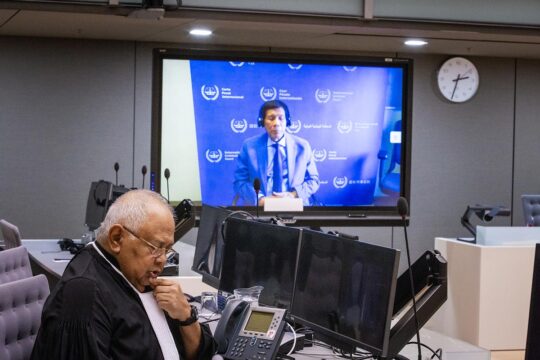The National Inquiry into Missing and Murdered Indigenous Women and Girls found that an ongoing genocide of Indigenous peoples constitutes a root cause of the violence that is currently being perpetrated against Indigenous women and girls. Genocide is a centerpiece of the National Inquiry's report, which argues that colonial violence is ongoing, not just a legacy of the past. Its 231 Calls for Justice reflect the legal obligation to stop genocide through a range of policy and process changes.
Indigenous women are at least six times more likely to be the victims of a homicide than non-Indigenous women.
Numbers are difficult to ascertain, as they keep growing, but nearly two decades of studies and reports in Canada have uncovered more than 1,200 names of Indigenous women who are known to have been killed or who have simply disappeared. Indigenous women are at least six times more likely to be the victims of a homicide than non-Indigenous women. In September 2016, after years of inaction, the Canadian government, along with the 13 provincial and territorial governments, mandated the National Inquiry into Missing and Murdered Indigenous Women and Girls to report on, notably, “systemic causes of all forms of violence – including sexual violence – against Indigenous women and girls in Canada, including underlying social, economic, cultural, institutional and historical causes contributing to the ongoing violence and particular vulnerabilities of Indigenous women and girls in Canada.”
The debate that followed was predictable and has been mostly divided into two camps, writes Heidi Matthews: “Those who are relieved to see the public directly confronted with an argument that Indigenous activists and scholars have been making for years, and those who argue that using genocide to describe Canada’s relationship with its Indigenous populations dilutes the significance and effectiveness of the term,” the latter compounded with a profound repugnance to associate Canada with the “crime of crimes.”
Canadians have been, collectively, given a history of themselves that is not accurate.
This division, also present in the legal community, exemplifies, in our view, the profound divergence of knowledge and experience of our colonial past and its legacies. Canadians have been, collectively, given a history of themselves that is not accurate. The split is also linked to a restrictive understanding of genocide in international law, which is often taken for granted.
What is colonial genocide?
The National Inquiry published a Supplementary Report on the legal basis for using the term genocide. The definition it adopted has been welcomed by the UN Special Rapporteur on the Rights of Indigenous Peoples, while calls for action and further examination were made by the UN High Commissioner for Human Rights and the Organization of American States.
Colonial genocide is a slow-moving process. Unlike the traditional paradigms of genocide, such as the Holocaust and the genocide in Rwanda.
To understand the true nature of genocide, we must dissociate from popular notions of it. Colonial genocide is a slow-moving process. Unlike the traditional paradigms of genocide, such as the Holocaust and the genocide in Rwanda, which took place in determined periods of time and were characterized by mass killings, colonial intent to destroy Indigenous peoples has taken place insidiously and over centuries. It is structural, systemic, involves varied tactics, and traverses multiple administrations and political leadership.
While the development of international criminal law has privileged individual accountability for the crime of genocide, international law also upholds state responsibility. The National Inquiry’s analysis does not deal with the criminal liability of individuals. It asserts that colonial genocide elicits the responsibility of Canada as a state. Canada’s colonial structures and policies, established by successive political administrations and maintained over decades, comprise numerous distinct acts and omissions which, in aggregate, violate the international prohibition against genocide.
Genocide as a gendered crime
Under international law, genocide is defined as certain prohibited acts or omissions, carried out with the intent to destroy, in whole or in part, a protected group of people. There are five forms of prohibited conduct, which encompass a variety of both lethal and non-lethal acts, including acts of “slow death.” Killing is only one of them. Other conduct that can amount to genocide includes inflicting mental or physical harm, such as sexual violence; imposing conditions of life meant to bring about physical destruction, such as lack of adequate food, water, or medical care; imposing measures intended to prevent births, such as forced sterilisation; and the forced transfer of children from the group, such as Canada’s residential schools system and the Sixties Scoop.
Moreover, genocide is a highly gendered crime: all of its constitutive acts have specific impacts on women and girls. To reduce genocide to mass-murder erases gendered experiences of genocidal violence and ignores the reality that targeted violence against women aggravates and amplifies the crime’s destructive impact on the whole group. For instance, rape and sexual violence against women and girls carries social stigma and deep psychological ramifications that “break down the bonds between members of the targeted community, reducing social cohesion and diminishing the ability of the protected group to replenish itself through sexual reproduction,” specifies the Global Justice Center. These consequences result in a ‘slow death’ of the group and are no less destructive than immediate killings. Such a gendered lens can be applied to all constitutive acts of genocide, which reveal deeply gendered conceptions of dominance, power, and masculinity.
The National Inquiry’s report, read in conjunction with reports from the 1991 Aboriginal Justice Inquiry of Manitoba, the 1996 Royal Commission on Aboriginal Peoples, the 2001 Aboriginal Justice Implementation Commission, and the 2015 Truth and Reconciliation Commission, provides ample evidence of Canadian policies, many of which especially impact Indigenous women and girls, that constitute genocidal conduct.
Proving the intent of a state
The second legal element of genocide is the specific intent to destroy, in whole or in part, the protected group. This “specific intent” element is somewhat fictional when assessing state responsibility, because, unlike an individual, a state is an abstract entity with no mind or thoughts. Consequently, the intent of a state can only be evidenced by policy, and more specifically a manifest pattern of conduct over time that demonstrate the state’s “intent” to destroy a particular group. This destruction is predominantly understood in international jurisprudence to be physical or biological, but it also includes, in the National Inquiry’s opinion, the destruction of a group as a social unit. While this is admittedly a more progressive interpretation of ‘destruction’ than that of some international criminal tribunals, the National Inquiry reached this conclusion through methods of treaty interpretation based on the Vienna Convention on the Law of Treaties and a literature review of divergent jurisprudential and doctrinal sources.
Including the destruction of groups as social units within the scope of genocidal destruction is also consistent with the National Inquiry’s gender-sensitive approach to understanding genocidal intent. Focusing on mass killings completely ignores how other genocidal acts included in the definition – which often affect women and girls disproportionately – destroy the very foundations of the group as a social unit and leave long-lasting scars within a group’s social fabric that are inherent to its destruction.
The National Inquiry highlighted a pattern of genocidal policies in Canada from the Indian Act and the Residential Schools, to the Sixties Scoop and the continued forced sterilisation of Indigenous women. Through these policies, Canada has displayed its intent to destroy Indigenous peoples physically, biologically, and as social units. These policies have persisted to the present day and have had devastating impacts on Indigenous communities, particularly women and girls.
Engaging in an honest and active decolonization process
Beyond the law and the search for legal responsibility, genocide must also be understood as a process. As Andrew Woolford wrote, genocide is “a complex coordination of activities, habits, ideologies, motives and intents” that, in the Canadian colonial context, has collectively aimed at the elimination of Indigenous peoples.
Genocide is not about the result, nor about numbers.
Genocide is not about the result, nor about numbers. Indigenous communities in Canada have consistently resisted, subverted, and survived destructive policies, but this does not make these policies any less genocidal. More than anything, it is testament to the resilience and strength of Indigenous peoples.
Characterizing Canada’s treatment of Indigenous peoples as genocide does not negate the past or current suffering of other communities, nor does it weaken the term “genocide”. It also does not distract from the need to address and remedy the violence that is being perpetrated against Indigenous women and girls. To the contrary, labelling atrocities is itself a form of justice, an important acknowledgement of the lived experiences of victims and survivors. It is an imperative part of building the future on a common understanding of the past, and an essential ingredient of reconciliation.
This is the first time a sitting Prime Minister has acknowledged genocide within their own country.
The Canadian government has bravely accepted the Inquiry’s conclusion, which is accompanied by the legal obligation to end this genocide. It is only the second time that an official report in a settler state has pronounced a finding of genocide, and the first time a sitting Prime Minister has acknowledged genocide within their own country. We believe it changes history.
Colonial states with Indigenous populations have traditionally operated in a very defensive mode, particularly with respect to their history. This recognition of Canada’s harmful actions as a state from its nascence to the present, is the foundation for the path forward. The National Inquiry has provided 231 Calls for Justice in its final report, which must be seen as legal imperatives and the corollary to accepting responsibility for genocide against Indigenous peoples in Canada. For these calls to be fully implemented, it is paramount that Canadians engage in an honest and active decolonization of all facets of Canadian society, and this process must start now.
THE AUTHORS
The authors contributed to the National Inquiry into Missing and Murdered Women and Girls' legal analysis on genocide.
 FANNIE LAFONTAINE
FANNIE LAFONTAINE
Fannie Lafontaine is a lawyer, full professor at Université Laval (Québec, Canada) and holder of the Canada Research Chair in International Criminal Justice and Human Rights. She is Director of the Canadian Partnership for International Justice and founder and Co-Director of the Université Laval's International Criminal and Humanitarian Law Clinic.
 AMANDA GHAHREMANI
AMANDA GHAHREMANI
Amanda Ghahremani is an international criminal lawyer, co-investigator of the Canadian Partnership for International Justice, and the former Legal Director of the Canadian Centre for International Justice, where she assisted survivors of atrocity crimes to seek redress.
 CATHERINE SAVARD
CATHERINE SAVARD
Catherine Savard is pursuing her LL.M at Université Laval under the supervision of Professor Fannie Lafontaine. She is also assistant coordinator of the Canadian Partnership for International Justice. Her research focuses on genocide, colonialism, and cultural genocide.






